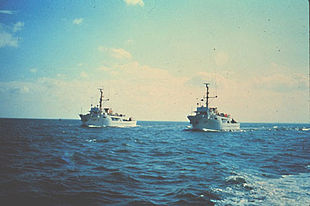- NOAAS Heck (S 591)
-

Sister ships NOAAS Rude (S 590) and NOAAS Heck (S 591)Career (United States)  _
_

Name: NOAAS Heck (S 591) Namesake: Captain Nicholas Heck (1882-1953), a U.S. Coast and Geodetic Survey officer Builder: Jackobson Shipyard, Oyster Bay, New York Launched: 1966 Acquired: 11 March 1967 (delivery to NOAA) Decommissioned: 1995 Struck: 1995 Honors and
awards:Department of Commerce Silver Medal 1978 Fate: Sold 2001 Notes: Served in U.S. Coast and Geodetic Survey as USC&GS Heck 1967-1970
Served in National Oceanic and Atmospheric Administration as NOAAS Heck (S 591) 1970-1995General characteristics Type: hydrographic Survey ship Tonnage: 150 gross register tons (domestic tonnage) Displacement: 220 long tons (220 t) (ITC tons) Length: 90 ft (27 m) Beam: 22 ft (6.7 m) (molded) Draft: 7.2 ft (2.2 m) Installed power: 850 shaft horsepower (630 kilowatts) Propulsion: Two Cummins 425-horsepower (317 kW) geared diesel engines, 2 shafts, 3,900 U.S. gallons (15,000 L) fuel Speed: 10 knots (cruising) Range: 1,000 nautical miles (1,850 kilometers) Endurance: 5 days Boats and landing
craft carried:One launch Complement: 11 (4 NOAA Corps officers, 1 licensed engineer, and 6 other crew members) Notes: 120 kilowatts electrical power NOAAS Heck (S 591), previously USC&GS Heck, was a hydrographic survey ship that served in the United States Coast and Geodetic Survey from 1967 to 1970 and in the National Oceanic and Atmospheric Administration from 1970 to 1995.
Contents
Construction and commissioning
Heck was built at the Jackobson Shipyard in Oyster Bay, New York. She was launched in 1966 and delivered to the Coast and Geodetic Survey on 11 March 1967. She entered service that year as USC&GS Heck. When the Coast and Geodetic Survey merged with other United States Government organizations to form NOAA in 1970, Heck became part of the NOAA fleet as NOAAS Heck (S 591).
Capabilities and characteristics
 A United States Coast and Geodetic Survey diagram of ca. 1920 of wire drag hydrographic survey operations as carried out by Rude and her sister ship Heck. The basic principle is to drag a wire attached to two vessels; if the wire encounters an obstruction it will come taut and form a "V".
A United States Coast and Geodetic Survey diagram of ca. 1920 of wire drag hydrographic survey operations as carried out by Rude and her sister ship Heck. The basic principle is to drag a wire attached to two vessels; if the wire encounters an obstruction it will come taut and form a "V".
Heck and her sister ship NOAAS Rude (S 590) were designed to conduct wire drag survey operations together, and the Coast and Geodetic Survey acquired them to replace the survey ships USC&GS Hilgard and USC&GS Wainwright in that role. Like Hilgard and Wainright before them, Rude and Heck worked together under a single command conducting wire drag surveys, clearing large swaths between them with a submerged wire. During their careers, however, electronic and acoustic technologies arrived that allowed a single ship to do the same work as two wire-drag vessels, using side-scan sonar or multibeam sonar. As a result, Heck and Rude began to operate independently in 1989, employing the improved technology.
Heck's deck equipment featured one winch and one telescoping boom crane, giving her a lifting capacity of up to 7,500 pounds (3,400 kilograms), as well 500 feet (150 meters) of cable that could pull up to 250 pounds (113 kilograms). She had 11 bunk spaces, and her mess room couls seat seven. She was equipped for diving operations to allow human investigation of submerged obstacles. She had a 19-foot (5.7 meter) fiberglass launch for utility or rescue operations.
Operational history
Heck spent her career operating along the United States East Coast and in the Gulf of Mexico.
In 1978, Rude and Heck came to the assistance of the burning research vessel Midnight Sun, rescuing Midnight Sun's crew and scientists and saving the vessel from total loss. Rude's crew took aboard all 20 of Midnight Sun's crew members and scientists, who were afloat in life rafts near Midnight Sun, administered first aid to them, and transported them to shore. Heck's crew, meanwhile, fought the fire aboard Midnight Sun for 20 consecutive hours and saved Midnight Sun from sinking. For their efforts in saving Midnight Sun and her crew, the crews of Rude and Heck received the 1978 Department of Commerce Silver Medal.
Heck was decommissioned in 1995 and sold in 2001.
See also
References
- NOAA History, A Science Odyssey: Tools of the Trade: Coast and Geodetic Survey Ships: Heck
- NOAA History, A Science Odyssey: Hall of Honor: Commerce Medals Presented for Lifesaving and the Protection of Property 1955-2000
- NOAA Marine Operations: NOAA Ship Rude
- Shipbuildinghistory.com Jackobson Shipyard
List of National Oceanic and Atmospheric Administration shipsCategories:- Ships of the National Oceanic and Atmospheric Administration
- Survey ships of the United States
- Rude class hydrographic survey ships
- Ships built in New York
- 1966 ships
Wikimedia Foundation. 2010.
